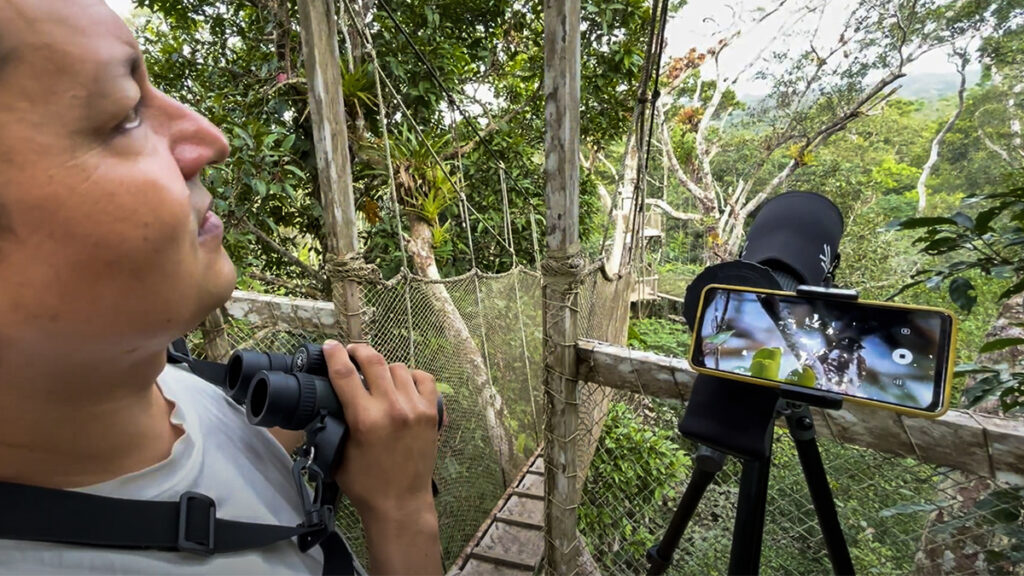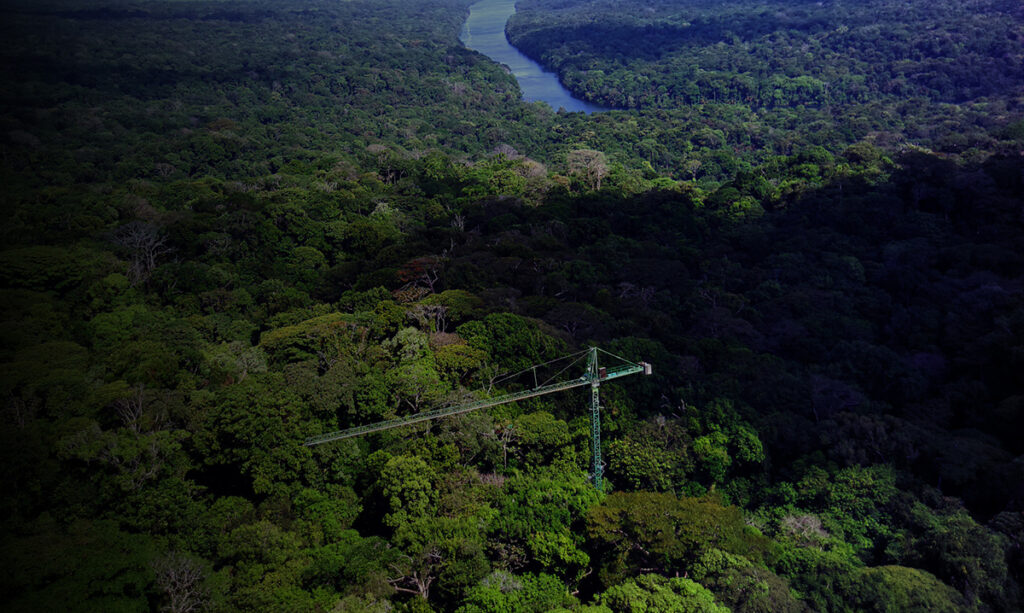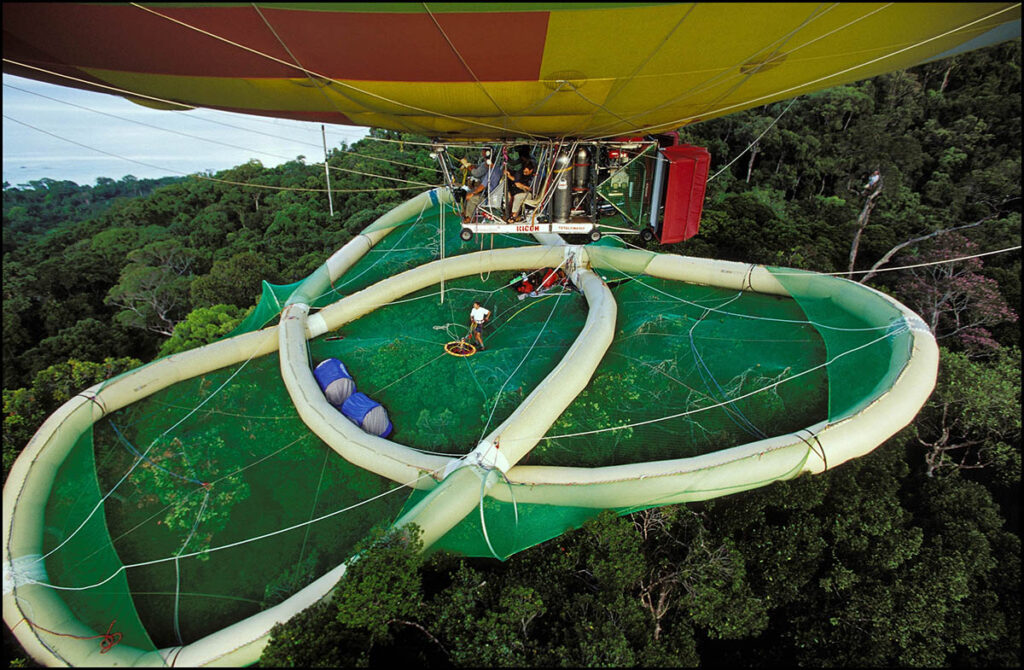
Madison Ryan
ACEER Intern
Madison is a Junior at West Chester University studying English with a minor in Media and Culture. She has always loved to read, write, research, and learn about the world around me through education and travel.
Learn more about Madison Ryan
March 28, 2023
Reaching for the treetops: Canopy Walkway Systems
The Amazon, like other tropical forests, consists of distinct layers. Each layer holds a myriad of microhabitats. The herbaceous layer of the forest is at ground level followed by woody shrubs, understory trees, canopy trees and finally giant emergent trees that penetrate the forest canopy and can reach heights of over 150 feet. These layers and their microhabitats help explain the unparalleled biodiversity of the forest. Studying these layers has become easier ever since the development of Canopy Access Systems (CAS).
CAS are tools designed to reach the crown of the tree, where researchers can obtain more information that they could not do so from the ground. With the acceleration of deforestation at alarming rates, along with anticipated widespread impacts of climate change, CAS are beneficial because they are a valuable tool for studying tropical forests that are invaluable to us all. As stated by Margaret Lowman, “forest canopies contribute directly to the global economy by providing oxygen (centers of photosynthesis), medicines, materials, foods, genetic libraries, nutrient cycling, carbon storage, climate stabilization, including fresh water conservation, and a vast cultural heritage.” (2012). For comprehensive studies to collect meaningful results, accessibility to tree canopies of tropical forests is essential.

The protection of the trees in tropical forests is vital because:
- 75% of all living organisms in tropical rainforests live in the canopy
- There is the possibility of discovering new species of plants and animals living in the canopy (as Dr. Lowman did!)
- The large amount of biodiversity found within the canopy is reflective of the unique resources provided by the canopy to animals and invertebrates, not to mention natural factors such as wind speed and light intensity which are heavily affected by the canopy (Nadkarni et al., 2000).
What began as a somewhat recreational activity for people interested in climbing and discovery, canopy studies grew to be a priority in the scientific community. However, before the heights and innovations used to reach them were invented, studies were accomplished by using binoculars from a distance, picking up what fell from the trees like plants or animals, or the study of branches. (Gottsberger, 2017). However, throughout the decades came many types of ways to access canopies, some of which may seem a little unusual, but still effective.
Types of CASs
Crane System
One fascinating type of CAS was inspired by construction at an airport, when a forest ecologist was traveling by plane and the construction cranes sparked an inventive idea that would help change how forests are studied. The crane system became quite popular and successful but comes with the downside of loud noise and the significant amount of space needed to be used. Gerhard Gottsberger explains that the cranes attracted interest and therefore, “in 1997, the creation of the International Canopy Crane Network (ICCN) had begun. By 2003, the network included six cranes in temperate and five in tropical forests.” (2017). Gottsberger described that some cranes ran on a rail track which increased ground disturbances and required a greater opening of the forest floor to enable the crane to work. However, the cranes on rail tracks cover more study area compared to fixed cranes.

Single Rope Technique
A more affordable and one of the first methods for canopy access were single rope techniques. These were developed in the 1980s, and could safely deliver scientists to the canopy, enabling them to study as they stayed attached to a rope. This method was not fully effective because it did not allow them to reach the uppermost canopy. These flaws in the rope technique led to new tools that would permit researchers to reach the top. “Ladders, scaffolds, walkways, canopy booms, hot air balloons, and construction cranes all provided access to slightly different regions of the treetops, and hence enabled researchers to answer different questions.” (Lowman & Schowalter, 2012).

Walkways
Canopy Walkways are typically built strategically; placed carefully in between trees and made with materials in order to blend in with the forest. Such CAS methods are advantageous because of their simplicity. ACEER teamed up with an array of partners to successfully build two canopy walkways, and were the first to do so in the Western Hemisphere. The first walkway was built in 1991, designed by Illar Muul in the Peruvian Amazon north of Iquitos near the Maijuna village of Sucusari. It consisted of a series of suspension bridges rising from the forest floor and culminating at a giant emergent tree. An observation platform was built on key trees and supported by a unique rubber attachment system that would cushion the tree and allow for adjustment as the tree continues to grow. A decade later in the Wayqecha Cloud Forest in the Andes, ACEER partnered with the Amazon Conservation Association to construct a research platform which became the first freestanding aluminum CAS. Both systems are still used today.

Rafts and Hot Air Balloon Systems
When canopy rafts and hot air balloon systems were first invented, children and other people uninterested in science were fascinated by these cool methods used for discovery. It was a way to attract the general public to scientific studies. ‘Radeau des Cimes’ was designed by Frenchman Francis Hallé and translates to ‘Treetop Raft’ in English. He did this with the help of graphic designer Dany Clayet-Marrel. (Weber, 1989). Although there was little ecological disturbance and noise while using a hot air balloon and raft as a CAS tool, other methods such as canopy walkways came to be valued as more permanent and comfortable.

CAS Impact
In a book written about her work, Margaret Lowman exclaims that she, “did not anticipate that, beyond their research function, walkways would become such a major link between nature and the public.” (2006). She noted that walkways are good for ecotourism and provide a new, educational way to explore and study the canopies. They allow visitors to learn more about the treetops by viewing the biodiversity up close, and they help people gain awareness of the importance of conservation by seeing what happens above the floor of the forest.
The walkways have become a major link between nature and the public. The emotional impact of experiencing these walkways cannot be understated.
The emotional impact of experiencing these walkways cannot be understated. During an ACEER educational workshop attended by rural Amazonian teachers, ACEER president Dr. Roger Mustalish met a group of teachers at a Canopy Walkway platform at the very top of a giant emergent tree. The teachers were quite moved by the experience, and some were even crying. When he asked why, the teachers replied that although they were born and raised in the rainforest, they had never seen the extent and majesty of the forest until now…and that it would impact how they taught about the forest going forward.
The impacts of CAS on scientific research are exceptional. They provide unique opportunities for experiential learning in tropical forests which, in turn, lead to greater understanding and innovative methods of protecting these forests. Meanwhile, visitors and communities can now gain the experience and wonder of being up close and personal with forests and their biodiversity.
References
Canopy Access Cranes (2022, June 15). Smithsonian Tropical Research Institute
https://stri.si.edu/facility/canopy-access-cranes
Gottsberger, G. (2017). Canopy Operation Permanent Access System: a novel tool for working in the canopy of tropical forests: history, development, technology and perspectives. Trees, 31, 791-812.
https://doi.org/10.1007/s00468-016-1515-1
Lowman, M., Burgess, E., & Burgess, J. (2006). It’s a jungle up there more tales from the treetops. Yale University Press. https://doi.org/10.12987/9780300153415
Lowman, M. D., & Schowalter, T. D., (2012). Plant science in forest canopies – the first 30 years of advances and challenges (1980–2010). The New Phytologist, 194(1), 12–27. http://www.jstor.org/stable/newphytologist.194.1.12
Nadkarni, N. M., Parker, G. G., Ford, E. D., Cushing, J. B., Stallman, C. (2000). The International Canopy Network: A Pathway for Interdisciplinary Exchange of Scientific Information on Forest Canopies. From, https://www.academia.edu/14416716/The_International_Canopy_Network_A_Pathway_for_Interdisciplinary_Exchange_of_Scientific_Information_on_Forest_Canopies
Weber, B. (1989). WORKS IN PROGRESS; Treed. The New York Times.
https://www.proquest.com/docview/427477066?pq-origsite=primo
